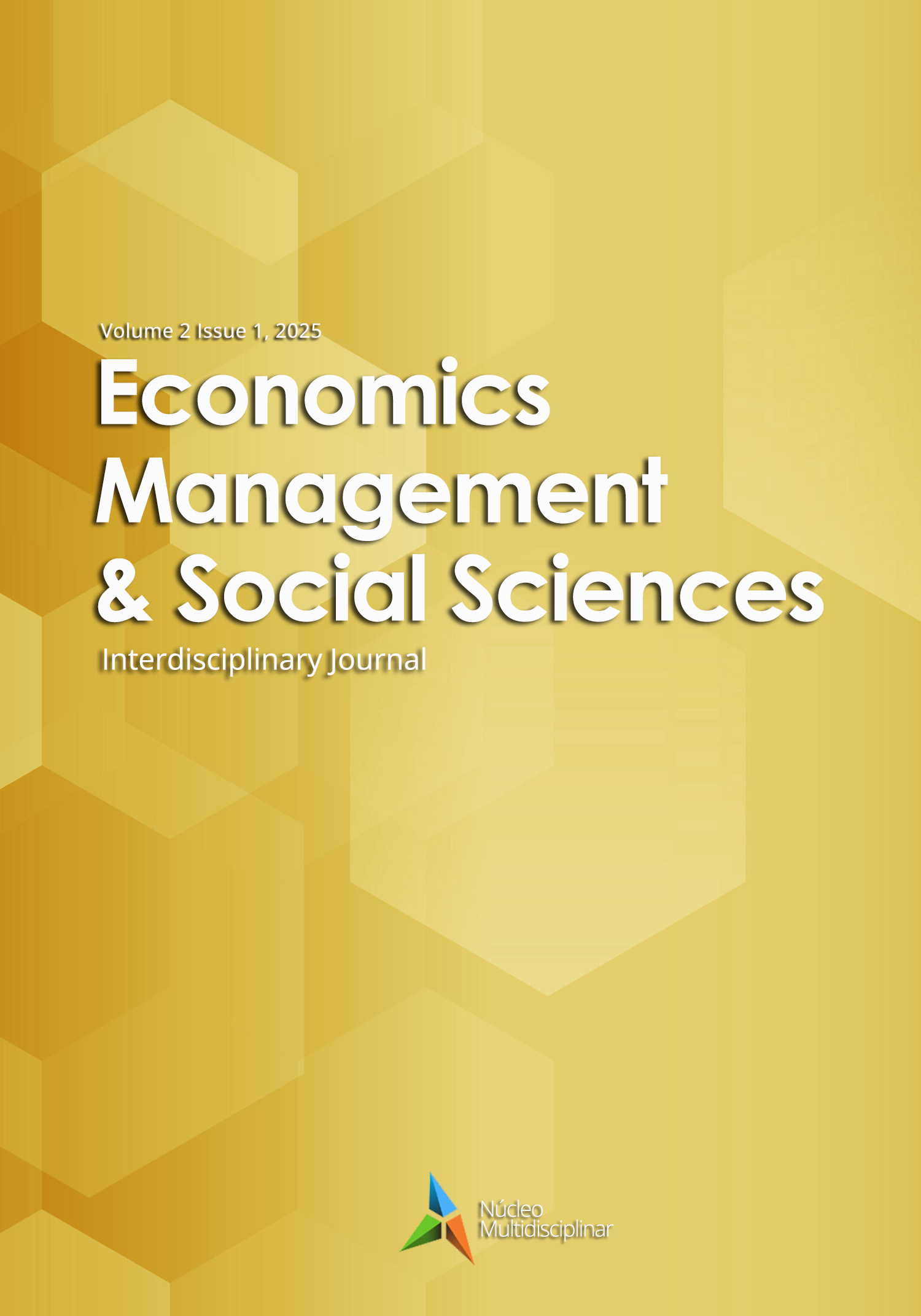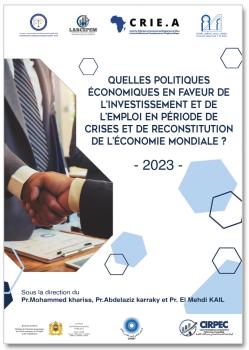Intégration économique et qualité de l’environnement en Afrique
Une approche en termes de Panel ARDL
DOI :
https://doi.org/10.23882/emss25114Mots-clés :
Environnement, Intégration économique, Commerce, IDE, Afrique, Panel ARDL, Croissance économiqueRésumé
Les pays africains se sont engagés dans la création des espaces de libre-échange considérés comme un moyen de consolider les liens commerciaux entre les nations africaines. Le commerce intra-africain est sensé relancer la croissance économique, améliorer les performances macroéconomiques et les standards de vie africains. Néanmoins, ces efforts risquent, selon des intuitions théoriques et des faits empiriques, d’être anéantis par des conséquences néfastes des échanges sur l’environnement qui sont à même d’entraver les réalisations en matière de développement durable et de réduction de la pauvreté sur le continent. Le présent papier vise à examiner l’impact environnemental du commerce intra-africain tout en intégrant les IDE, la croissance économique, l’urbanisation et la consommation d’énergie. L’étude a utilisé un ensemble de données de panel concernant 32 pays africains sur la période 1990-2020. L’analyse empirique s’est appuyée sur les dernières techniques d’estimation de panel. Plus précisément, nous avons mobilisé le test de causalité de Dumitrescu-Hurlin, la seconde génération de tests de racine unitaire sur données de panel et l’estimateur PMG pour estimer un Panel ARDL. Le terme de correction d’erreur dévoile l’existence d’une relation de cointégration entre CO2 et le commerce, l’IDE et les autres variables de contrôle. Les résultats trouvés suggèrent que le commerce intra-africain détériore à long terme la qualité de l’environnement en Afrique. De même, les IDE exercent un impact environnementale similaire corroborant ainsi l’hypothèse du "pollution heaven". En outre, les résultats ont infirmé l’existence de l’hypothèse de la courbe de Kuznets environnementale (EKC). La consommation d’énergie joue un rôle essentiel dans la détérioration de l’environnement à long terme. Enfin, l’urbanisation dégrade l’environnement conformément à l’intuition de la théorie de la transition environnementale urbaine.
Références
Abdouli, M., & Hammami, S. (2017). Investigating the causality links between environmental quality, foreign direct investment and economic growth in MENA countries. International Business Review, 26(2), 264 278. https://doi.org/10.1016/j.ibusrev.2016.07.004
Ahmed, K., Bhattacharya, M., Shaikh, Z., Ramzan, M., & Ozturk, I. (2017). Emission intensive growth and trade in the era of the Association of Southeast Asian Nations (ASEAN) integration : An empirical investigation from ASEAN-8. Journal of Cleaner Production, 154, 530 540. https://doi.org/10.1016/j.jclepro.2017.04.008
Asghari, M. (2013). Does FDI Promote MENA Region’s Environment Quality? Pollution Halo or Pollution Haven Hypothesis. International Journal of Scientific Research in Environmental Sciences.
Awad, A. (2019). Does economic integration damage or benefit the environment? Africa’s experience. Energy Policy, 132, 991 999. https://doi.org/10.1016/j.enpol.2019.06.072
Awad, A., & Yossof, I. (2016). Electricity Production, Economic Growth and Employment Nexus in Sudan : A cointegration Approach. International Journal of Energy Economics and Policy, 6(1), Article 1.
Baek, J. (2016). A new look at the FDI–income–energy–environment nexus : Dynamic panel data analysis of ASEAN. Energy Policy, 91, 22 27. https://doi.org/10.1016/j.enpol.2015.12.045
Ben Jebli, M., & Ben Youssef, S. (2017). Renewable energy consumption and agriculture : Evidence for cointegration and Granger causality for Tunisian economy. International Journal of Sustainable Development & World Ecology, 24(2), 149 158. https://doi.org/10.1080/13504509.2016.1196467
Chandia, K. E., Gul, I., Aziz, S., Sarwar, B., & Zulfiqar, S. (2018). An analysis of the association among carbon dioxide emissions, energy consumption and economic performance : An econometric model. Carbon Management, 9(3), 227 241. https://doi.org/10.1080/17583004.2018.1457930
Chandra Voumik, L., Rahman, Md. H., & Hossain, Md. S. (2022). Investigating the subsistence of Environmental Kuznets Curve in the midst of economic development, population, and energy consumption in Bangladesh : Imminent of ARDL model. Heliyon, 8(8), e10357. https://doi.org/10.1016/j.heliyon.2022.e10357
Chebbi, H. E., Olarreaga, M., & Zitouna, H. (2011). Trade openness and co2 emissions in tunisia. Middle East Development Journal, 03(01), 29 53. https://doi.org/10.1142/S1793812011000314
Cole, M. A., Elliott, R. J. R., & Fredriksson, P. G. (2006). Endogenous Pollution Havens : Does FDI Influence Environmental Regulations? The Scandinavian Journal of Economics, 108(1), 157 178.
DOTS (Direction Of Trade Statistics) , base de données de FMI.
Du, Q., Zhou, J., Pan, T., Sun, Q., & Wu, M. (2019). Relationship of carbon emissions and economic growth in China’s construction industry. Journal of Cleaner Production, 220, 99 109. https://doi.org/10.1016/j.jclepro.2019.02.123
Ertugrul, H. M., Çetin, M., Şeker, F., & Dogan, E. (2015, novembre 11). The impact of trade openness on global carbon dioxide emissions : Evidence from the top ten emitters among developing countries [MPRA Paper]. https://mpra.ub.uni-muenchen.de/97539/
Farhani, S., Chaibi, A., & Rault, C. (2014). CO2 emissions, output, energy consumption, and trade in Tunisia. Economic Modelling, 38, 426 434. https://doi.org/10.1016/j.econmod.2014.01.025
Fodha, M., & Zaghdoud, O. (2010). Economic growth and pollutant emissions in Tunisia : An empirical analysis of the environmental Kuznets curve. Energy Policy, 38(2), 1150 1156. https://doi.org/10.1016/j.enpol.2009.11.002
Fotros, M. H., & Maaboudi, R. (2011). The impact of trade openness on CO2 emissions in Iran, 1971-2005. Conference Papers, Article 332030.
Frankel, J. A. (2009). Environmental Effects of International Trade. HKS Faculty Research Working Paper Series. https://dash.harvard.edu/handle/1/4481652
Granger, C. W. J. (1969). Investigating Causal Relations by Econometric Models and Cross-spectral Methods. Econometrica, 37(3), 424 438. https://doi.org/10.2307/1912791
Grossman, G. M., & Krueger, A. B. (1996). The inverted-U : What does it mean? Environment and Development Economics, 1(1), 119 122. https://doi.org/10.1017/S1355770X00000450
Hanif, I., Faraz Raza, S. M., Gago-de-Santos, P., & Abbas, Q. (2019). Fossil fuels, foreign direct investment, and economic growth have triggered CO2 emissions in emerging Asian economies : Some empirical evidence. Energy, 171(C), 493 501.
IEA ( International Energy Agency), base de données de l’OCDE.
Jones, D. W. (1991). How urbanization affects energy-use in developing countries. Energy Policy, 19(7), 621 630. https://doi.org/10.1016/0301-4215(91)90094-5
Kao, C. (1999). Spurious regression and residual-based tests for cointegration in panel data. Journal of Econometrics, 90(1), 1 44. https://doi.org/10.1016/S0304-4076(98)00023-2
Khobai, H., & Roux, P. L. (2017). The Relationship between Energy Consumption, Economic Growth and Carbon Dioxide Emission : The Case of South Africa. International Journal of Energy Economics and Policy, 7(3), 102 109.
Kivyiro, P., & Arminen, H. (2014). Carbon dioxide emissions, energy consumption, economic growth, and foreign direct investment : Causality analysis for Sub-Saharan Africa. Energy, 74(C), 595 606.
Kohler, M. (2013). CO2 emissions, energy consumption, income and foreign trade : A South African perspective. Energy Policy, 63, 1042 1050. https://doi.org/10.1016/j.enpol.2013.09.022
Le, T.-H., Chang, Y., & Park, D. (2016). Trade openness and environmental quality : International evidence. Energy Policy, 92, 45 55. https://doi.org/10.1016/j.enpol.2016.01.030
Lee, J. W. (2013). The contribution of foreign direct investment to clean energy use, carbon emissions and economic growth. Energy Policy, 55, 483 489. https://doi.org/10.1016/j.enpol.2012.12.039
Menyah, K., & Wolde-Rufael, Y. (2010). CO2 emissions, nuclear energy, renewable energy and economic growth in the US. Energy Policy, 38(6), 2911 2915. https://doi.org/10.1016/j.enpol.2010.01.024
Naranpanawa, A. (2011). Does Trade Openness Promote Carbon Emissions? Empirical Evidence from Sri Lanka. https://www.semanticscholar.org/paper/Does-Trade-Openness-Promote-Carbon-Emissions-from-Naranpanawa/e399e54b8c2ebbdf0f4d2be3008a0d4c918a3e13
Pao, H.-T., & Tsai, C.-M. (2011). Multivariate Granger causality between CO2 emissions, energy consumption, FDI (foreign direct investment) and GDP (gross domestic product) : Evidence from a panel of BRIC (Brazil, Russian Federation, India, and China) countries. Energy, 36(1), 685 693. https://doi.org/10.1016/j.energy.2010.09.041
Paramati, S. R., Ummalla, M., & Apergis, N. (2016). The effect of foreign direct investment and stock market growth on clean energy use across a panel of emerging market economies. Energy Economics, 56, 29 41. https://doi.org/10.1016/j.eneco.2016.02.008
Pedroni, P. (2004). Panel Cointegration: Asymptotic and Finite Sample Properties of Pooled Time Series Tests with an Application to the PPP Hypothesis. Econometric Theory, 20(3), 597 625. https://doi.org/10.1017/S0266466604203073
Phuc Nguyen, C., Schinckus, C., & Dinh Su, T. (2020). Economic integration and CO2 emissions : Evidence from emerging economies. Climate and Development, 12(4), 369 384. https://doi.org/10.1080/17565529.2019.1630350
Rashid Gill, A., Viswanathan, K. K., & Hassan, S. (2018). The Environmental Kuznets Curve (EKC) and the environmental problem of the day. Renewable and Sustainable Energy Reviews, 81, 1636 1642. https://doi.org/10.1016/j.rser.2017.05.247
Ren, S., Yuan, B., Ma, X., & Chen, X. (2014). International trade, FDI (foreign direct investment) and embodied CO2 emissions : A case study of Chinas industrial sectors. China Economic Review, 28, 123 134. https://doi.org/10.1016/j.chieco.2014.01.003
S. Wang, S., Li, Q., Fang, C., & Zhou, C. (2016). The relationship between economic growth, energy consumption, and CO2 emissions : Empirical evidence from China. Science of The Total Environment, 542, 360 371. https://doi.org/10.1016/j.scitotenv.2015.10.027
Saboori, B., & Sulaiman, J. (2013). CO2 emissions, energy consumption and economic growth in Association of Southeast Asian Nations (ASEAN) countries : A cointegration approach. Energy, 55(C), 813 822.
Samreen, I., & Majeed, M. T. (2020). Spatial econometric model of the spillover effects of financial development on carbon emissions : A global analysis. Pakistan Journal of Commerce and Social Sciences (PJCSS), 14(2), 569 602.
Sarkodie, S. A., & Strezov, V. (2019). Effect of foreign direct investments, economic development and energy consumption on greenhouse gas emissions in developing countries. Science of The Total Environment, 646, 862 871. https://doi.org/10.1016/j.scitotenv.2018.07.365
Shahbaz, M., Balsalobre-Lorente, D., & Sinha, A. (2019). Foreign direct Investment–CO2 emissions nexus in Middle East and North African countries : Importance of biomass energy consumption. Journal of Cleaner Production, 217, 603 614. https://doi.org/10.1016/j.jclepro.2019.01.282
Shahbaz, M., Mutascu, M., & Azim, P. (2013). Environmental Kuznets curve in Romania and the role of energy consumption. Renewable and Sustainable Energy Reviews, 18, 165 173. https://doi.org/10.1016/j.rser.2012.10.012
Shahbaz, M., Nasreen, S., Ahmed, K., & Hammoudeh, S. (2017). Trade openness–carbon emissions nexus : The importance of turning points of trade openness for country panels. Energy Economics, 61, 221 232. https://doi.org/10.1016/j.eneco.2016.11.008
Sharif Hossain, M. (2011). Panel estimation for CO2 emissions, energy consumption, economic growth, trade openness and urbanization of newly industrialized countries. Energy Policy, 39(11), 6991 6999.
Spangenberg, J. H. (2007). Biodiversity pressure and the driving forces behind. Ecological Economics, 61(1), 146 158. https://doi.org/10.1016/j.ecolecon.2006.02.021
Wang, Q., Zhang, F., Li, R., & Li, L. (2022). The impact of renewable energy on decoupling economic growth from ecological footprint – An empirical analysis of 166 countries. Journal of Cleaner Production, 354, 131706. https://doi.org/10.1016/j.jclepro.2022.131706
WDI (Word Developement Indicators) , base de données de la Banque Mondiale.
Wei, G., He, B.-J., Sun, P., Liu, Y., Li, R., Ouyang, X., Luo, K., & Li, S. (2023). Evolutionary trends of urban expansion and its sustainable development : Evidence from 80 representative cities in the belt and road initiative region. Cities, 138, 104353. https://doi.org/10.1016/j.cities.2023.104353
Westerlund, J. (2005). New Simple Tests for Panel Cointegration. Econometric Reviews, 24(3), 297 316. https://doi.org/10.1080/07474930500243019
Y. Wang, Y., Chen, L., & Kubota, J. (2016). The relationship between urbanization, energy use and carbon emissions : Evidence from a panel of Association of Southeast Asian Nations (ASEAN) countries. Journal of Cleaner Production, 112, 1368 1374. https://doi.org/10.1016/j.jclepro.2015.06.041
Yang, M., Gao, X., Siddique, K. H. M., Wu, P., & Zhao, X. (2023). Spatiotemporal exploration of ecosystem service, urbanization, and their interactive coercing relationship in the Yellow River Basin over the past 40 years. Science of The Total Environment, 858, 159757. https://doi.org/10.1016/j.scitotenv.2022.159757
Zakarya, G. Y., Mostefa, B., Abbes, S. M., & Seghir, G. M. (2015). Factors Affecting CO2 Emissions in the BRICS Countries : A Panel Data Analysis. Procedia Economics and Finance, 26, 114 125. https://doi.org/10.1016/S2212-5671(15)00890-4
Téléchargements
Publiée
Comment citer
Numéro
Rubrique
Licence
(c) Tous droits réservés Mouna Ouarhi, Mustapha ZIKY, Rachid OUCHCHIKH 2024

Ce travail est disponible sous licence Creative Commons Attribution - Pas d’Utilisation Commerciale 4.0 International.







